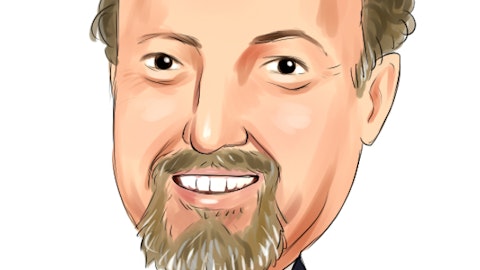Stephanie Price: I was hoping that just given the increasing spend with TI and — going over to TI as CFO, if you can talk a little bit about how you see that relationship with TI evolving over time. And then for my second question, hoping you can touch on the additional restructuring costs of roughly $300 million in 2024. In a tougher economic environment, do we assume more of an annual cadence to restructuring as you look to optimize the business? And related Doug, I think you mentioned that you expect EBITDA growth to build over the year, and I assume that might be restructuring related as well.
Darren Entwistle: Zainul given the criticality of the relationship between our consumer business and TI, why don’t you speak to that and Jeff you’re on the call, if you got a few things that you want to top up on post Zainul’s answer, I think that would be great. And Doug, you and I can handle restructuring. Zainul?
Zainul Mawji: I think you’ll definitely see us, as I mentioned, around, the public review as well that we’re going to continue to synergize and leverage TI effectively across our business. And you can see that there are AMPU opportunities from an end-to-end perspective. Customers are wanting more digitized solutions. What we’re doing with TI is also ensuring that we build exciting new product road map capabilities that we can own ourselves, we can license from an end-to-end perspective to other peers in the industry globally and that reduce our costs and create an opportunity for us to really own our destiny in terms of our product roadmaps. So you’ll see more of that to come and it accelerates our opportunity to drive those gains because we’re not dependent on a third-party.
We have a synergistic relationship with TI across development. And then on the overall cost per customer perspective, leveraging TI enables us to support the demands of our customers in a product intensity environment. We’re serving our customers across numerous products and we’re able to leverage TI to scale those capabilities and provide quality and excellence in our customer service profile. And so, while we’re going to continue to digitize our customer support and ensure that, we build a more streamlined customer journeys as we’ve done with public mobile, we’re also able to lean on our relationship with partnership with TI and the depth of experience in TI in terms of supporting our business over years and over the transitions we’ve made from things like copper-to-fiber and from new products that we’ve offered in the market.
I think you’ll continue to see that synergistic relationship evolve and you’ll see it bidirectional with respect to supporting us on our growth and AMPU objectives and us supporting TI in terms of leveraging those solutions more globally. Maybe, Jeff, you wanted to top up.
Jeff Puritt: A few things I would add. The symbiotic relationship between TELUS and TI is by no means new. That has been in place as part of our originating thesis at first instance, TELUS International enabling TELUS in its digital transformation and delighting customers through the combination of talent and technology. But at the same time, TELUS International then repatriating that learning from serving other customers, bringing those back to TELUS. And then what we do within for TELUS, enables us to go and take that show on the road, so to speak, and serve other customers, certainly principally in the Telecom and Media segment, but by no means exclusively given the obvious similar dynamics in the buying behaviors and challenges that customers in the BFSI, healthcare and other segments are challenged with as well.
I think consistent with that symbiotic dynamic, whilst we’re certainly adding to see [indiscernible] bringing Gopi on board is a part of the robust coordinated succession planning, again, an opportunity for both TI and TELUS to benefit from one another’s access to a global talent pool, and Gopi having proven herself as a trusted leader and advisor and advocate within the TELUS organization for the past 14 years, brings to TI an opportunity to further strengthen the connection between the two organizations. And as Zainul just pointed out, the opportunities prospectively to continue to enable one another. And similarly, Navin’s comments earlier on the healthcare front, I think the environment just becomes that much more target rich bidirectional.
Darren Entwistle: Doug, you want to comment on restructuring?
Doug French: Yes. On the restructuring side, we still have an elevated amount of restructuring within the real estate portfolio. So as Tony highlighted, we have a significant opportunity and the rationalization of real estate, not just in coordination with the copper decommissioning, but even within our own office footprint and aligning the way we do business and the way our team members work today versus that the old historical footprint that we have. So I’d say a little more than a third of it is going to be the elevated real estate, which we have in year again. There’s a portion of it for M&A and integration and some of the items that we would normally see as well and then the remaining is the ongoing efficiency and effectiveness program.
And if you remember, our ongoing run rate is generally $150 million to $200 million. So we are elevated maybe $100 million next year, but it’s a combination of all those items and trying to leverage all the assets that we have in front of us.
Operator: Next question comes from Simon Flannery.
Simon Flannery: I wanted to just come to the 2024 outlook and particularly around the wireless industry. Maybe you could just talk about the sustainability we’ve seen across the whole industry this quarter, this year is really strong loading. I know the government is looking at foreign student visas or permits. How do you think about the sustainability of the current growth rates for the industry? And then you specifically called out the churn has been better than peers, but still not where you want it to be. So perhaps just unpack how you think you can bring that down. Are you already seeing some normalization in Q1?
Darren Entwistle: Zainul and Navin, I’ll hand that over to you to comment. Darren Entwistle, so we cover up both the consumer side, but also, the B2B side, particularly in respect of IoT as well. Zainul, why don’t you go first and Navin, you can complement.
Zainul Mawji: So, I think we are focused on continued premium and high quality product intensity loading. And we’re also focused as I mentioned, in some of the discussion on public on penetrating areas that where we have been under penetrated in the past. And I think that there is tremendous growth opportunity for us and our organization in that regard that can — we will obviously be impacted by the macroeconomic environment, but I think that there are growth prospects for us as we have been under penetrated in some of those segments. And we’ve been under penetrated from a product intensity perspective in some regions of Canada, which I think we can continue to pursue. So when it comes to churn, as Darren highlighted, we have been, of course, ahead of the industry and ahead of our peers, but we’re not satisfied.
And what it’s taught us from a performance perspective is that we’re going to have to continue to advance our product intensity and bundling place for all segments of the market and have more attractive bundles for all segments of the market. And when you look at the assets that we have and our ability to accelerate the go-to-market of those assets as we discussed with TI, we have tremendous upside opportunity. Clients are responding to our desire to see greater product intensity and create greater value from them. And I think you can see that in areas like security and smart home automation, which we will continue to evolve. You can see that in areas like health and other areas that we’re continuing to bundle. And you can see it in our very unique and differentiated content strategies.
As an example, we were the 1st in the world to launch, the new version of Stream Plus 2.0, which bundles Netflix, Disney Plus and Amazon Prime for the first time ever. And so these types of offers are going to continue to resonate with our base and continue to drive product intensity and continue to differentiate us relative to our peers. And I think that those are the kinds of areas that we’ll continue to lean into to improve our churn results.
Darren Entwistle: Thanks Zainul. I appreciate the commentary on judicious loading in respected quality and the potency on our retention front, the continued focus on efficiency through to the AMPU level, and how we win on the marketplace as it relates to bundling. Navin, do you want to comment?
Navin Arora: Yes. Thanks, Darren. Just building on Zainul’s comments, similar thought process on the B2B side. So first and foremost, we are very focused on high quality, good margin loading. We’re not going to chase non-profitable or low profitable loading. I think there’s a significant market growth opportunity that we still have on the B2B space. There are natural geographies where we have a lot more addressable market to go after and that’s what we’re focused on. I think on the bundling point, again, as I mentioned on my response in health, what a great differentiator for our B2B organizations. And we can leverage that in terms of the cross-sell and strategic value or solution value we can provide customers with a combination of telecommunications and health capabilities.
So, lots we can do there and lots of opportunity for growth and intensity. And then on the 5G or monetizing 5G side, we continue to remain very bullish in terms of our ability to monetize 5G. As you heard and saw in our results really strong momentum with IoT and connected device growth. We have a natural differentiator there with Canada’s only dedicated IoT core network. Data monetization, it’s a bit of a marathon, not a sprint, but it is becoming more and more of a growth story across both our vertical and horizontal services and applications. Private wireless network, we had very, very strong momentum in 2023 and an even stronger funnel in 2024. And so we’ll continue to look at intelligent ways to monetize 5G. We will look at smart tuck-in acquisitions where it makes sense.





